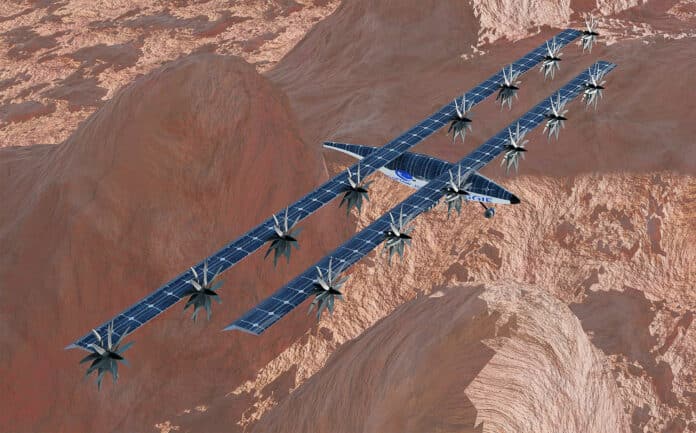After the successful test flight of the Ingenuity helicopter, NASA has proposed a new concept for a fixed-wing aircraft that can fly above the Martian surface. This concept, known as the Mars Aerial and Ground Intelligent Explorer (MAGGIE), was recently announced under the NASA Innovative Advanced Concepts (NIAC) Program.
MAGGIE is a compact fixed-wing aircraft with ultra-high productivity efficiency powered by solar energy to fly in the Martian atmosphere. It can take off and land vertically (VTOL) thanks to its innovative deflected slipstream technology with CoFlow Jet (CFJ).
MAGGIE can cruise at Mach 0.25 with a lift coefficient CL of 3.5, nearly 10 times higher than conventional subsonic aircraft. This is a remarkable feat, considering the low density of the Martian atmosphere. The ultra-high cruise CL with CL/CDc of 9 is made possible by CFJ, which overcomes the low Reynolds number effect on Mars.
MAGGIE has a range of 179 km for a fully charged battery per 7.6 Martian days (sol) at an altitude of 1,000 meters. Its entire range is estimated to be an impressive 16,048 kilometers during a Martian year.
The representative mission for MAGGIE aims to conduct three atmospheric and geophysical investigations that support different timescales of the Dynamic Mars science theme. These investigations include studying the origin and timing of the Martian core dynamo from the weak magnetic fields found in the large impact basins, conducting a regional investigation of the source of methane signals detected by the Tunable Laser Spectrometer on the Mars Science Laboratory in Gale crater, and mapping subsurface water ice at high resolution in the mid-latitudes where it has been observed from orbit.
MAGGIE system study suggests that the concept could be viable, but more research, design, and verification under Martian atmospheric conditions are necessary in Phase I. If successful, MAGGIE could perform the first global-scale atmospheric mission on Mars and open up new possibilities for exploring almost all of the Martian surface.
Compared to other concepts, NASA says MAGGIE is the first to enable ongoing exploration of this region of Mars and would represent a significant advancement in its exploration of the Red Planet.
The idea of airborne missions on Mars has already proven to be captivating with the Ingenuity helicopter. MAGGIE would be similarly compelling to the public, both in its audacity and the diverse environments it could explore, study, and image. The technology would also contribute to the development of VTOL aircraft technology on Earth and other planets.
